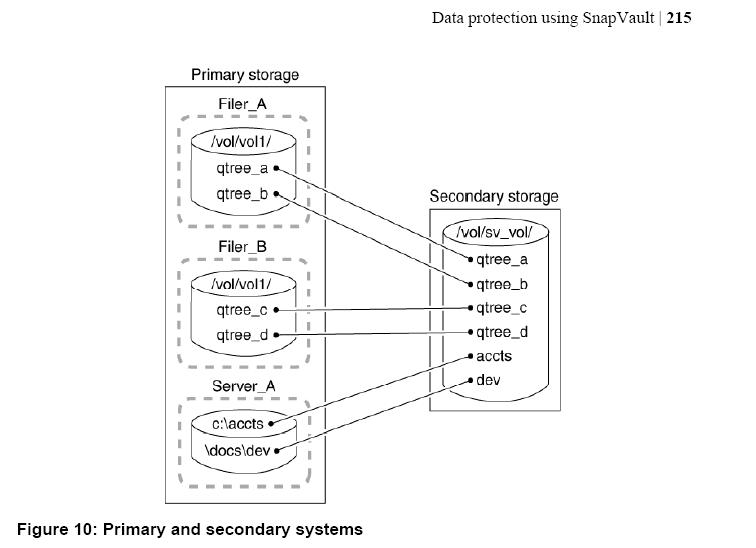ONTAP Discussions
- Home
- :
- ONTAP, AFF, and FAS
- :
- ONTAP Discussions
- :
- OSSV Backup to Qtree?
ONTAP Discussions
- Subscribe to RSS Feed
- Mark Topic as New
- Mark Topic as Read
- Float this Topic for Current User
- Bookmark
- Subscribe
- Mute
- Printer Friendly Page
- Mark as New
- Bookmark
- Subscribe
- Mute
- Subscribe to RSS Feed
- Permalink
- Report Inappropriate Content
Hello
I'm installing a snapvault environment with a FAS2020 as secondary Snapvault and OSSV on Windows Server as primary Snapvault.
The configuration of the jobs/relationships happens with the DFM/Protection Manager (Management Console).
If I create a dataset and protect them with a policy, it is only possible to specify a Volume on the FAS2020 as destination...
Is it required to create a volume for every dataset/policy?
If i study the command line commands from OSSV/Snapvault, it seems to be possible to set a qtree as a destination?
Whats wrong?
regards,
simon
- Mark as New
- Bookmark
- Subscribe
- Mute
- Subscribe to RSS Feed
- Permalink
- Report Inappropriate Content
Hi Simon,
If I create a dataset and protect them with a policy, it is only possible to specify a Volume on the FAS2020 as destination...Is it required to create a volume for every dataset/policy?
Not required.A secondary volume can backup upto 50 ossv path.Example, if you add a windows box to the dataset, which has 2 drive, and 1 systemstate
then PM creates 3 qtrees inside the secondary volume.Like this one secondary volume accommodate upto 50 qtrees or 50 ossv 50.
When the 51st path comes in the same dataset the second volume is created.
Is it required to create a volume for every dataset/policy?
If they belong to a different dataset, yes each dataset will create one secondary volume.
As one destination volume cannot be a member of multiple dataset.
If i study the command line commands from OSSV/Snapvault, it seems to be possible to set a qtree as a destination?
True that cli allows, but PM doesn't because, in case of say same volume being shared across 2 dataset, which have different schedule times and different retention settings for backup.
Then there would be conflict and that's the reason PM doesn't allow you to use same volume across multiple datasets.
Regards
adai
- Mark as New
- Bookmark
- Subscribe
- Mute
- Subscribe to RSS Feed
- Permalink
- Report Inappropriate Content
Hi adai and all others 🙂
Thanks for your answer... they are very helpful for me.
I've some question again to the topic of snapvault...
- Where are the snapvault relationsships saved which are created with Protection Manager? I can't find anything in the snapvault.conf file on the filer? --> How is it perhaps possible to check if the right throttle is set and so on?
- How is it possible to manualy delete an ossv relationsship on the ossv host? I can't find the right command :-(...
- It seems to be, that it is only possible to attach one Policy to a Dataset - i'm looking for a solution to set the throttle on weekends to none and on workdays to a limit... with to policy it will be possible... is there an other solution to do this?
- Is it possible to activate deduplication on the secondary volume if i'm working with ressource pool, the filer is a fas2020 with a limitations for dedup of 1TB. The volumes from the default provisioning are the maximum size with file reservation. other solution?
regards,
simon
- Mark as New
- Bookmark
- Subscribe
- Mute
- Subscribe to RSS Feed
- Permalink
- Report Inappropriate Content
OSSV Backup to Qtree?
Adaikkappan,thanks for your answer. I think you're hitting on what I'm trying to understand. A NetApp Best Practices Guide shows a many to one relationship between the primary and secondary storage. They include OSSV, see "Server A" in this diagram:

And in the manual they say that putting the backups to the same location on the secondary (qtree, I think) we will get better benefit of deduplication. So why do they mention is words and pictures that this is best but not allow it from Protection Manager? Or, am I misunderstanding this great new world of NetApp?
cheers,
Keivn
- Mark as New
- Bookmark
- Subscribe
- Mute
- Subscribe to RSS Feed
- Permalink
- Report Inappropriate Content
It is allowed from Protection Manager. As Adai mentioned up to 50 OSSV relationships can be stuffed into a single destination volume. Regardless if you are using CLI or Protection Manager, the OSSV relationships will land in separate qtrees within the destination volume. The qtrees are created during the first backup.
A best practice is to "group like data together" and this is true for CLI and Protection Manager. If you create a single Protection Manager dataset for 30 OSSV relationships they will all backup to multiple qtrees in a single destination volume. However if some of the OSSV clients had different retention requirements you would split them into different datasets. This would result in separate destination volumes.
- Mark as New
- Bookmark
- Subscribe
- Mute
- Subscribe to RSS Feed
- Permalink
- Report Inappropriate Content
By Protection Manager does exactly what you showed. But the default value for this options is 1. If you like to FAN-In Multple primary volumes into one single qtree pls change the following option to the value you like.
[root@vmlnx ~]# dfm options list | grep -i fan
dpMaxFanInRatio 1
[root@vmlnx ~]#
BTW this options is applicable only for SV and QSM and not for VSM as its always 1:1.
As chris said we already do this by default for OSSV, where we accommodate upto 50 primary directories/drives in 1 secondary volume irrespective of host from which they originate.
The is controller by a option which can be increased or decreased.
Regards
adai
